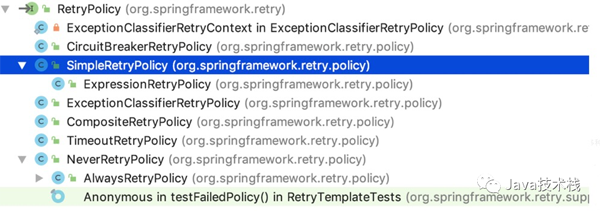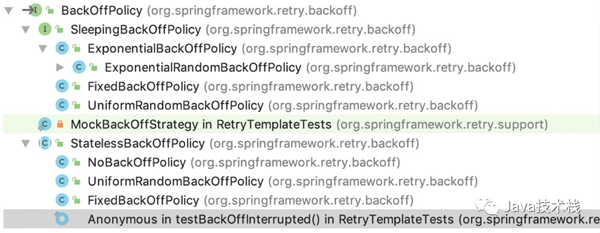这篇文章主要介绍“如何使用spring中的重试机制”,在日常操作中,相信很多人在如何使用Spring中的重试机制问题上存在疑惑,小编查阅了各式资料,整理出简单好用的操作方法,希望对大家解答”如何使用Spring中的重试机制”的疑惑有所帮助!
这篇文章主要介绍“如何使用spring中的重试机制”,在日常操作中,相信很多人在如何使用Spring中的重试机制问题上存在疑惑,小编查阅了各式资料,整理出简单好用的操作方法,希望对大家解答”如何使用Spring中的重试机制”的疑惑有所帮助!接下来,请跟着小编一起来学习吧!
背景
重试,其实我们其实很多时候都需要的,为了保证容错性,可用性,一致性等。一般用来应对外部系统的一些不可预料的返回、异常等,特别是网络延迟,中断等情况。还有在现在流行的微服务治理框架中,通常都有自己的重试与超时配置,比如dubbo可以设置retries=1,timeout=500调用失败只重试1次,超过500ms调用仍未返回则调用失败。
如果我们要做重试,要为特定的某个操作做重试功能,则要硬编码,大概逻辑基本都是写个循环,根据返回或异常,计数失败次数,然后设定退出条件。这样做,且不说每个操作都要写这种类似的代码,而且重试逻辑和业务逻辑混在一起,给维护和扩展带来了麻烦。
从面向对象的角度来看,我们应该把重试的代码独立出来。
使用介绍
基本使用
先举个例子:
@Configuration @EnableRetry public class Application { @Bean public RetryService retryService(){ return new RetryService(); } public static void main(String[] args) throws Exception{ ApplicationContext applicationContext = new AnnotationConfigApplicationContext("springretry"); RetryService service1 = applicationContext.getBean("service", RetryService.class); service1.service(); } } @Service("service") public class RetryService { @Retryable(value = IllegalAccessException.class, maxAttempts = 5, backoff= @Backoff(value = 1500, maxDelay = 100000, multiplier = 1.2)) public void service() throws IllegalAccessException { System.out.println("service method..."); throw new IllegalAccessException("manual exception"); } @Recover public void recover(IllegalAccessException e){ System.out.println("service retry after Recover => " + e.getMessage()); } }@EnableRetry - 表示开启重试机制
@Retryable - 表示这个方法需要重试,它有很丰富的参数,可以满足你对重试的需求
@Backoff - 表示重试中的退避策略
@Recover - 兜底方法,即多次重试后还是失败就会执行这个方法
Spring-Retry 的功能丰富在于其重试策略和退避策略,还有兜底,监听器等操作。
然后每个注解里面的参数,都是很简单的,大家看一下就知道是什么意思,怎么用了,我就不多讲了。关注公众号Java技术栈,在后台回复:spring,可以获取我整理的 Spring 系列教程,非常齐全。
重试策略
看一下Spring Retry自带的一些重试策略,主要是用来判断当方法调用异常时是否需要重试。(下文原理部分会深入分析实现)

SimpleRetryPolicy 默认最多重试3次
TimeoutRetryPolicy 默认在1秒内失败都会重试
ExpressionRetryPolicy 符合表达式就会重试
CircuitBreakerRetryPolicy 增加了熔断的机制,如果不在熔断状态,则允许重试
CompositeRetryPolicy 可以组合多个重试策略
NeverRetryPolicy 从不重试(也是一种重试策略哈)
AlwaysRetryPolicy 总是重试
….等等
退避策略
看一下退避策略,退避是指怎么去做下一次的重试,在这里其实就是等待多长时间。(下文原理部分会深入分析实现)

FixedBackOffPolicy 默认固定延迟1秒后执行下一次重试
ExponentialBackOffPolicy 指数递增延迟执行重试,默认初始0.1秒,系数是2,那么下次延迟0.2秒,再下次就是延迟0.4秒,如此类推,最大30秒。
ExponentialRandomBackOffPolicy 在上面那个策略上增加随机性
UnifORMRandomBackOffPolicy 这个跟上面的区别就是,上面的延迟会不停递增,这个只会在固定的区间随机
StatelessBackOffPolicy 这个说明是无状态的,所谓无状态就是对上次的退避无感知,从它下面的子类也能看出来
原理
原理部分我想分开两部分来讲,一是重试机制的切入点,即它是如何使得你的代码实现重试功能的;二是重试机制的详细,包括重试的逻辑以及重试策略和退避策略的实现。另外,关注公众号Java技术栈,在后台回复:面试,可以获取我整理的 Spring 系列面试题和答案,非常齐全。
切入点
@EnableRetry
@Target(ElementType.TYPE) @Retention(RetentionPolicy.RUNTIME) @EnableAspectJAutoProxy(proxyTargetClass = false) @Import(RetryConfiguration.class) @Documented public @interface EnableRetry { boolean proxyTargetClass() default false; }我们可以看到@EnableAspectJAutoProxy(proxyTargetClass = false)这个并不陌生,就是打开Spring aop功能。
重点看看@Import(RetryConfiguration.class)@Import相当于注册这个Bean
我们看看这个RetryConfiguration是个什么东西:

它是一个AbstractPointcutAdvisor,它有一个pointcut和一个advice。我们知道,在ioc过程中会根据PointcutAdvisor类来对Bean进行Pointcut的过滤,然后生成对应的AOP代理类,用advice来加强处理。
看看RetryConfiguration的初始化:
@PostConstruct public void init() { Set<Class<? extends Annotation>> retryableAnnotationTypes = new LinkedHashSet<Class<? extends Annotation>>(1); retryableAnnotationTypes.add(Retryable.class); //创建pointcut this.pointcut = buildPointcut(retryableAnnotationTypes); //创建advice this.advice = buildAdvice(); if (this.advice instanceof BeanFactoryAware) { ((BeanFactoryAware) this.advice).setBeanFactory(beanFactory); } }protected Pointcut buildPointcut(Set<Class<? extends Annotation>> retryAnnotationTypes) { ComposablePointcut result = null; for (Class<? extends Annotation> retryAnnotationType : retryAnnotationTypes) { Pointcut filter = new AnnotationClassOrMethodPointcut(retryAnnotationType); if (result == null) { result = new ComposablePointcut(filter); } else { result.uNIOn(filter); } } return result; }上面代码用到了AnnotationClassOrMethodPointcut,其实它最终还是用到了AnnotationMethodMatcher来根据注解进行切入点的过滤。这里就是@Retryable注解了。
//创建advice对象,即拦截器 protected Advice buildAdvice() { //下面关注这个对象 AnnotationAwareRetryOperationsInterceptor interceptor = new AnnotationAwareRetryOperationsInterceptor(); if (retryContextCache != null) { interceptor.setRetryContextCache(retryContextCache); } if (retryListeners != null) { interceptor.setListeners(retryListeners); } if (methodArgumentsKeyGenerator != null) { interceptor.seTKEyGenerator(methodArgumentsKeyGenerator); } if (newMethodArgumentsIdentifier != null) { interceptor.setNewItemIdentifier(newMethodArgumentsIdentifier); } if (sleeper != null) { interceptor.setSleeper(sleeper); } return interceptor; }AnnotationAwareRetryOperationsInterceptor
继承关系

可以看出AnnotationAwareRetryOperationsInterceptor是一个MethodInterceptor,在创建AOP代理过程中如果目标方法符合pointcut的规则,它就会加到interceptor列表中,然后做增强,我们看看invoke方法做了什么增强。
@Override public Object invoke(MethodInvocation invocation) throws Throwable { MethodInterceptor delegate = getDelegate(invocation.getThis(), invocation.getMethod()); if (delegate != null) { return delegate.invoke(invocation); } else { return invocation.proceed(); } }这里用到了委托,主要是需要根据配置委托给具体“有状态”的interceptor还是“无状态”的interceptor。
private MethodInterceptor getDelegate(Object target, Method method) { if (!this.delegates.containsKey(target) || !this.delegates.get(target).containsKey(method)) { synchronized (this.delegates) { if (!this.delegates.containsKey(target)) { this.delegates.put(target, new HashMap<Method, MethodInterceptor>()); } Map<Method, MethodInterceptor> delegatesForTarget = this.delegates.get(target); if (!delegatesForTarget.containsKey(method)) { Retryable retryable = AnnotationUtils.findAnnotation(method, Retryable.class); if (retryable == null) { retryable = AnnotationUtils.findAnnotation(method.getDeclarinGClass(), Retryable.class); } if (retryable == null) { retryable = findAnnotationOnTarget(target, method); } if (retryable == null) { return delegatesForTarget.put(method, null); } MethodInterceptor delegate; //支持自定义MethodInterceptor,而且优先级最高 if (StringUtils.hasText(retryable.interceptor())) { delegate = this.beanFactory.getBean(retryable.interceptor(), MethodInterceptor.class); } else if (retryable.stateful()) { //得到“有状态”的interceptor delegate = getStatefulInterceptor(target, method, retryable); } else { //得到“无状态”的interceptor delegate = getStatelessInterceptor(target, method, retryable); } delegatesForTarget.put(method, delegate); } } } return this.delegates.get(target).get(method); }getStatefulInterceptor和getStatelessInterceptor都是差不多,我们先看看比较简单的getStatelessInterceptor。
private MethodInterceptor getStatelessInterceptor(Object target, Method method, Retryable retryable) { //生成一个RetryTemplate RetryTemplate template = createTemplate(retryable.listeners()); //生成retryPolicy template.setRetryPolicy(getRetryPolicy(retryable)); //生成backoffPolicy template.setBackOffPolicy(getBackoffPolicy(retryable.backoff())); return RetryInterceptorBuilder.stateless() .retryOperations(template) .label(retryable.label()) .recoverer(getRecoverer(target, method)) .build(); }具体生成retryPolicy和backoffPolicy的规则,我们等下再回头来看。
RetryInterceptorBuilder其实就是为了生成RetryOperationsInterceptor。RetryOperationsInterceptor也是一个MethodInterceptor,我们来看看它的invoke方法。
分享资料:Spring Boot 学习笔记太全了!
public Object invoke(final MethodInvocation invocation) throws Throwable { String name; if (StringUtils.hasText(label)) { name = label; } else { name = invocation.getMethod().toGenericString(); } final String label = name; //定义了一个RetryCallback,其实看它的doWithRetry方法,调用了invocation的proceed()方法,是不是有点眼熟,这就是AOP的拦截链调用,如果没有拦截链,那就是对原来方法的调用。 RetryCallback<Object, Throwable> retryCallback = new RetryCallback<Object, Throwable>() { public Object doWithRetry(RetryContext context) throws Exception { context.setAttribute(RetryContext.NAME, label); if (invocation instanceof ProxyMethodInvocation) { try { return ((ProxyMethodInvocation) invocation).invocableClone().proceed(); } catch (Exception e) { throw e; } catch (Error e) { throw e; } catch (Throwable e) { throw new IllegalStateException(e); } } else { throw new IllegalStateException( "MethodInvocation of the wrong type detected - this should not happen with Spring AOP, " + "so please raise an issue if you see this exception"); } } }; if (recoverer != null) { ItemRecovererCallback recoveryCallback = new ItemRecovererCallback( invocation.getArguments(), recoverer); return this.retryOperations.execute(retryCallback, recoveryCallback); } //最终还是进入到retryOperations的execute方法,这个retryOperations就是在之前的builder set进来的RetryTemplate。 return this.retryOperations.execute(retryCallback); }无论是RetryOperationsInterceptor还是StatefulRetryOperationsInterceptor,最终的拦截处理逻辑还是调用到RetryTemplate的execute方法,从名字也看出来,RetryTemplate作为一个模板类,里面包含了重试统一逻辑。
不过,我看这个RetryTemplate并不是很“模板”,因为它没有很多可以扩展的地方。推荐阅读:最新 Spring 系列教程。
重试逻辑及策略实现
上面介绍了Spring Retry利用了AOP代理使重试机制对业务代码进行“入侵”。下面我们继续看看重试的逻辑做了什么。RetryTemplate的doExecute方法。
protected <T, E extends Throwable> T doExecute(RetryCallback<T, E> retryCallback, RecoveryCallback<T> recoveryCallback, RetryState state) throws E, ExhaustedRetryException { RetryPolicy retryPolicy = this.retryPolicy; BackOffPolicy backOffPolicy = this.backOffPolicy; //新建一个RetryContext来保存本轮重试的上下文 RetryContext context = open(retryPolicy, state); if (this.logger.isTraceEnabled()) { this.logger.trace("RetryContext retrieved: " + context); } // Make sure the context is available globally for clients who need // it... RetrySynchronizationManager.reGISter(context); Throwable lastException = null; boolean exhausted = false; try { //如果有注册RetryListener,则会调用它的open方法,给调用者一个通知。 boolean running = doOpenInterceptors(retryCallback, context); if (!running) { throw new TerminatedRetryException( "Retry terminated abnormally by interceptor before first attempt"); } // Get or Start the backoff context... BackOffContext backOffContext = null; Object resource = context.getAttribute("backOffContext"); if (resource instanceof BackOffContext) { backOffContext = (BackOffContext) resource; } if (backOffContext == null) { backOffContext = backOffPolicy.start(context); if (backOffContext != null) { context.setAttribute("backOffContext", backOffContext); } } //判断能否重试,就是调用RetryPolicy的canRetry方法来判断。 //这个循环会直到原方法不抛出异常,或不需要再重试 while (canRetry(retryPolicy, context) && !context.isExhaustedOnly()) { try { if (this.logger.isDebugEnabled()) { this.logger.debug("Retry: count=" + context.getRetryCount()); } //清除上次记录的异常 lastException = null; //doWithRetry方法,一般来说就是原方法 return retryCallback.doWithRetry(context); } catch (Throwable e) { //原方法抛出了异常 lastException = e; try { //记录异常信息 registerThrowable(retryPolicy, state, context, e); } catch (Exception ex) { throw new TerminatedRetryException("Could not register throwable", ex); } finally { //调用RetryListener的onError方法 doOnErrorInterceptors(retryCallback, context, e); } //再次判断能否重试 if (canRetry(retryPolicy, context) && !context.isExhaustedOnly()) { try { //如果可以重试则走退避策略 backOffPolicy.backOff(backOffContext); } catch (BackOffInterruptedException ex) { lastException = e; // back off was prevented by another thread - fail the retry if (this.logger.isDebugEnabled()) { this.logger .debug("Abort retry because interrupted: count=" + context.getRetryCount()); } throw ex; } } if (this.logger.isDebugEnabled()) { this.logger.debug( "Checking for rethrow: count=" + context.getRetryCount() } if (shouldRethrow(retryPolicy, context, state)) { if (this.logger.isDebugEnabled()) { this.logger.debug("Rethrow in retry for policy: count=" + context.getRetryCount()); } throw RetryTemplate.<E>wrapifNecessary(e); } } if (state != null && context.hasAttribute(GLOBAL_STATE)) { break; } } if (state == null && this.logger.isDebugEnabled()) { this.logger.debug( "Retry failed last attempt: count=" + context.getRetryCount()); } exhausted = true; //重试结束后如果有兜底Recovery方法则执行,否则抛异常 return handleRetryExhausted(recoveryCallback, context, state); } catch (Throwable e) { throw RetryTemplate.<E>wrapIfNecessary(e); } finally { //处理一些关闭逻辑 close(retryPolicy, context, state, lastException == null || exhausted); //调用RetryListener的close方法 doCloseInterceptors(retryCallback, context, lastException); RetrySynchronizationManager.clear(); } }主要核心重试逻辑就是上面的代码了,看上去还是挺简单的。
在上面,我们漏掉了RetryPolicy的canRetry方法和BackOffPolicy的backOff方法,以及这两个Policy是怎么来的。我们回头看看getStatelessInterceptor方法中的getRetryPolicy和getRetryPolicy方法。
private RetryPolicy getRetryPolicy(Annotation retryable) { Map<String, Object> attrs = AnnotationUtils.getAnnotationAttributes(retryable); @SuppressWarnings("unchecked") Class<? extends Throwable>[] includes = (Class<? extends Throwable>[]) attrs.get("value"); String exceptionExpression = (String) attrs.get("exceptionExpression"); boolean hasExpression = StringUtils.hasText(exceptionExpression); if (includes.length == 0) { @SuppressWarnings("unchecked") Class<? extends Throwable>[] value = (Class<? extends Throwable>[]) attrs.get("include"); includes = value; } @SuppressWarnings("unchecked") Class<? extends Throwable>[] excludes = (Class<? extends Throwable>[]) attrs.get("exclude"); Integer maxAttempts = (Integer) attrs.get("maxAttempts"); String maxAttemptsExpression = (String) attrs.get("maxAttemptsExpression"); if (StringUtils.hasText(maxAttemptsExpression)) { maxAttempts = PARSER.parseExpression(resolve(maxAttemptsExpression), PARSER_CONTEXT) .getValue(this.evaluationContext, Integer.class); } if (includes.length == 0 && excludes.length == 0) { SimpleRetryPolicy simple = hasExpression ? new ExpressionRetryPolicy(resolve(exceptionExpression)) .withBeanFactory(this.beanFactory) : new SimpleRetryPolicy(); simple.setMaxAttempts(maxAttempts); return simple; } Map<Class<? extends Throwable>, Boolean> policyMap = new HashMap<Class<? extends Throwable>, Boolean>(); for (Class<? extends Throwable> type : includes) { policyMap.put(type, true); } for (Class<? extends Throwable> type : excludes) { policyMap.put(type, false); } boolean retryNotExcluded = includes.length == 0; if (hasExpression) { return new ExpressionRetryPolicy(maxAttempts, policyMap, true, exceptionExpression, retryNotExcluded) .withBeanFactory(this.beanFactory); } else { return new SimpleRetryPolicy(maxAttempts, policyMap, true, retryNotExcluded); } } 嗯~,代码不难,这里简单做一下总结好了。就是通过@Retryable注解中的参数,来判断具体使用文章开头说到的哪个重试策略,是SimpleRetryPolicy还是ExpressionRetryPolicy等。 private BackOffPolicy getBackoffPolicy(Backoff backoff) { long min = backoff.delay() == 0 ? backoff.value() : backoff.delay(); if (StringUtils.hasText(backoff.delayExpression())) { min = PARSER.parseExpression(resolve(backoff.delayExpression()), PARSER_CONTEXT) .getValue(this.evaluationContext, Long.class); } long max = backoff.maxDelay(); if (StringUtils.hasText(backoff.maxDelayExpression())) { max = PARSER.parseExpression(resolve(backoff.maxDelayExpression()), PARSER_CONTEXT) .getValue(this.evaluationContext, Long.class); } double multiplier = backoff.multiplier(); if (StringUtils.hasText(backoff.multiplierExpression())) { multiplier = PARSER.parseExpression(resolve(backoff.multiplierExpression()), PARSER_CONTEXT) .getValue(this.evaluationContext, Double.class); } if (multiplier > 0) { ExponentialBackOffPolicy policy = new ExponentialBackOffPolicy(); if (backoff.random()) { policy = new ExponentialRandomBackOffPolicy(); } policy.setInitialInterval(min); policy.setMultiplier(multiplier); policy.setMaxInterval(max > min ? max : ExponentialBackOffPolicy.DEFAULT_MAX_INTERVAL); if (this.sleeper != null) { policy.setSleeper(this.sleeper); } return policy; } if (max > min) { UniformRandomBackOffPolicy policy = new UniformRandomBackOffPolicy(); policy.setMinBackOffPeriod(min); policy.setMaxBackOffPeriod(max); if (this.sleeper != null) { policy.setSleeper(this.sleeper); } return policy; } FixedBackOffPolicy policy = new FixedBackOffPolicy(); policy.setBackOffPeriod(min); if (this.sleeper != null) { policy.setSleeper(this.sleeper); } return policy; }嗯~,一样的味道。就是通过@Backoff注解中的参数,来判断具体使用文章开头说到的哪个退避策略,是FixedBackOffPolicy还是UniformRandomBackOffPolicy等。
那么每个RetryPolicy都会重写canRetry方法,然后在RetryTemplate判断是否需要重试。我们看看SimpleRetryPolicy的
@Override public boolean canRetry(RetryContext context) { Throwable t = context.getLastThrowable(); //判断抛出的异常是否符合重试的异常 //还有,是否超过了重试的次数 return (t == null || retryForException(t)) && context.getRetryCount() < maxAttempts; }同样,我们看看FixedBackOffPolicy的退避方法。
protected void doBackOff() throws BackOffInterruptedException { try { //就是sleep固定的时间 sleeper.sleep(backOffPeriod); } catch (InterruptedException e) { throw new BackOffInterruptedException("Thread interrupted while sleeping", e); } }至此,重试的主要原理以及逻辑大概就是这样了。
RetryContext
我觉得有必要说说RetryContext,先看看它的继承关系。

可以看出对每一个策略都有对应的Context。
在Spring Retry里,其实每一个策略都是单例来的。我刚开始直觉是对每一个需要重试的方法都会new一个策略,这样重试策略之间才不会产生冲突,但是一想就知道这样就可能多出了很多策略对象出来,增加了使用者的负担,这不是一个好的设计。
Spring Retry采用了一个更加轻量级的做法,就是针对每一个需要重试的方法只new一个上下文Context对象,然后在重试时,把这个Context传到策略里,策略再根据这个Context做重试,而且Spring Retry还对这个Context做了cache。这样就相当于对重试的上下文做了优化。
到此,关于“如何使用Spring中的重试机制”的学习就结束了,希望能够解决大家的疑惑。理论与实践的搭配能更好的帮助大家学习,快去试试吧!若想继续学习更多相关知识,请继续关注编程网网站,小编会继续努力为大家带来更多实用的文章!
--结束END--
本文标题: 如何使用Spring中的重试机制
本文链接: https://www.lsjlt.com/news/280984.html(转载时请注明来源链接)
有问题或投稿请发送至: 邮箱/279061341@qq.com QQ/279061341
下载Word文档到电脑,方便收藏和打印~
2024-05-24
2024-05-24
2024-05-24
2024-05-24
2024-05-24
2024-05-24
2024-05-24
2024-05-24
2024-05-24
2024-05-24
回答
回答
回答
回答
回答
回答
回答
回答
回答
回答
一口价域名售卖能注册吗?域名是网站的标识,简短且易于记忆,为在线用户提供了访问我们网站的简单路径。一口价是在域名交易中一种常见的模式,而这种通常是针对已经被注册的域名转售给其他人的一种方式。
一口价域名买卖的过程通常包括以下几个步骤:
1.寻找:买家需要在域名售卖平台上找到心仪的一口价域名。平台通常会为每个可售的域名提供详细的描述,包括价格、年龄、流
443px" 443px) https://www.west.cn/docs/wp-content/uploads/2024/04/SEO图片294.jpg https://www.west.cn/docs/wp-content/uploads/2024/04/SEO图片294-768x413.jpg 域名售卖 域名一口价售卖 游戏音频 赋值/切片 框架优势 评估指南 项目规模
0